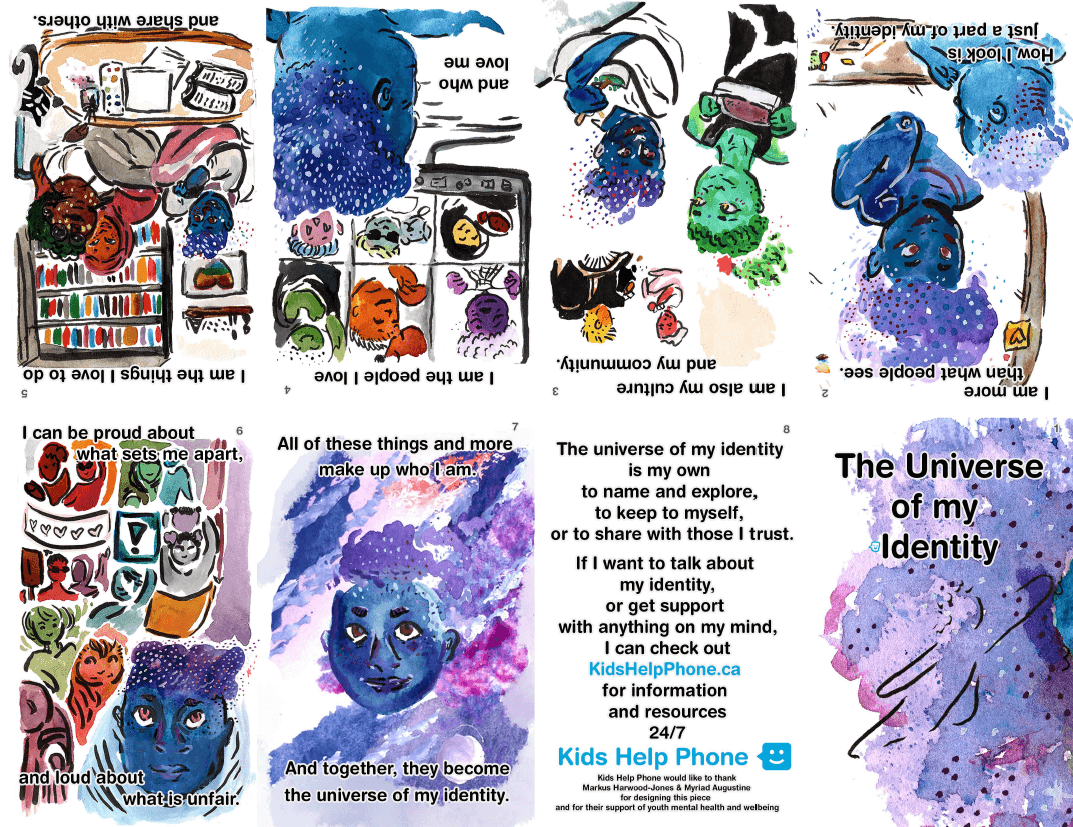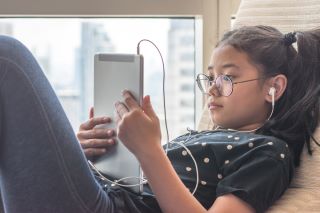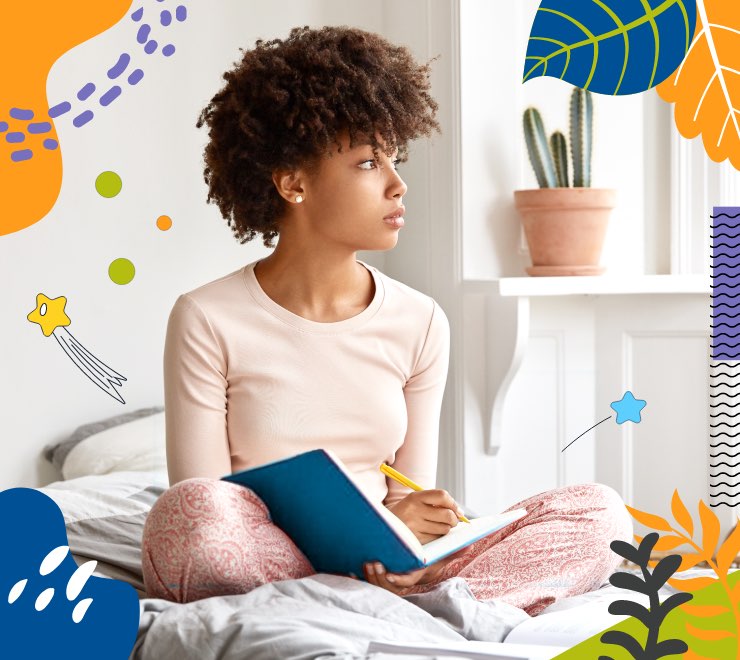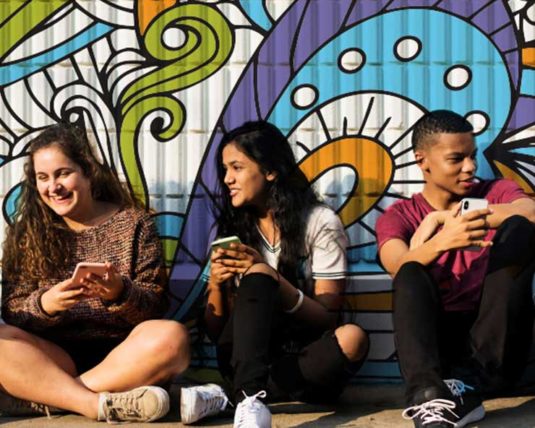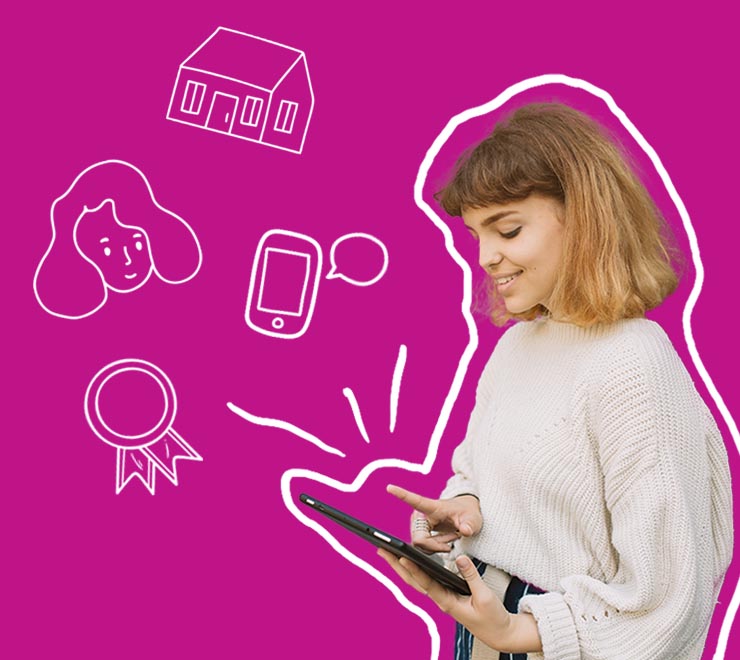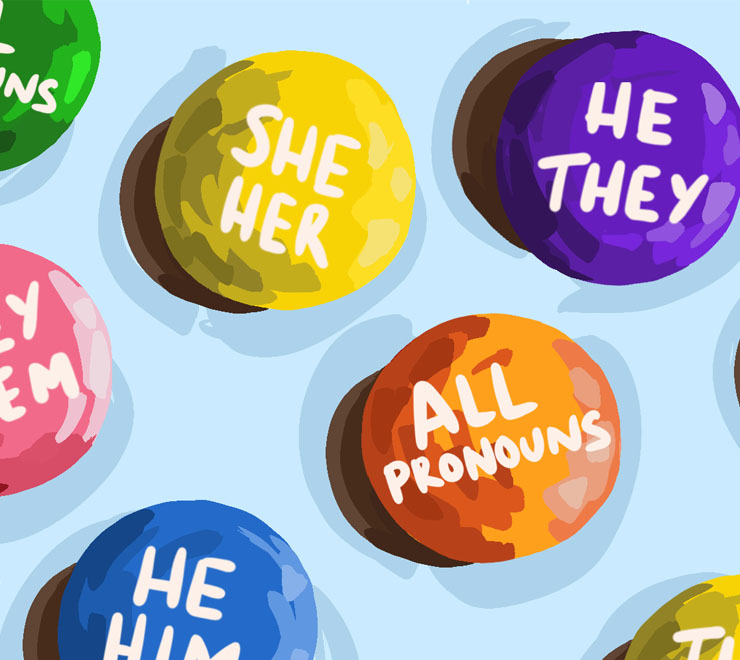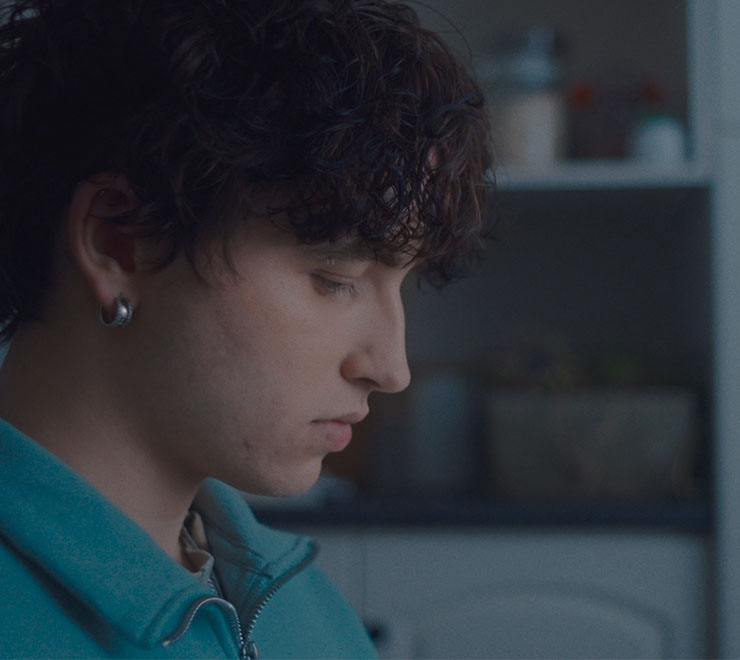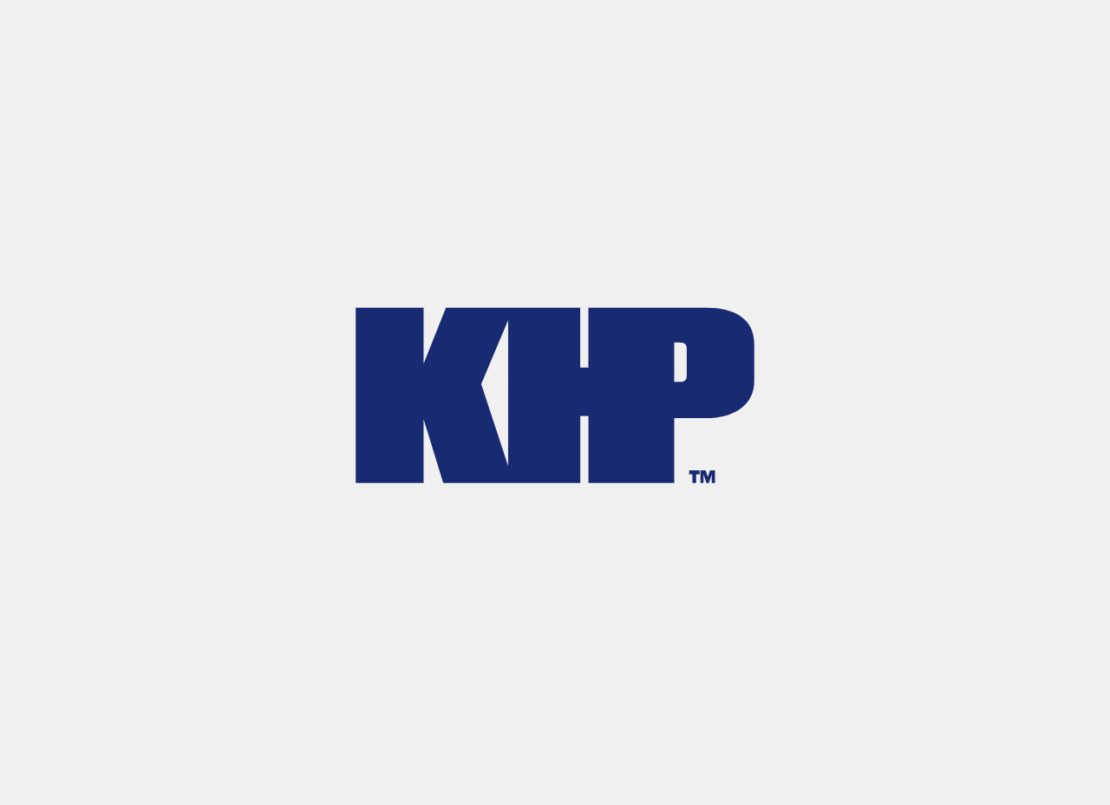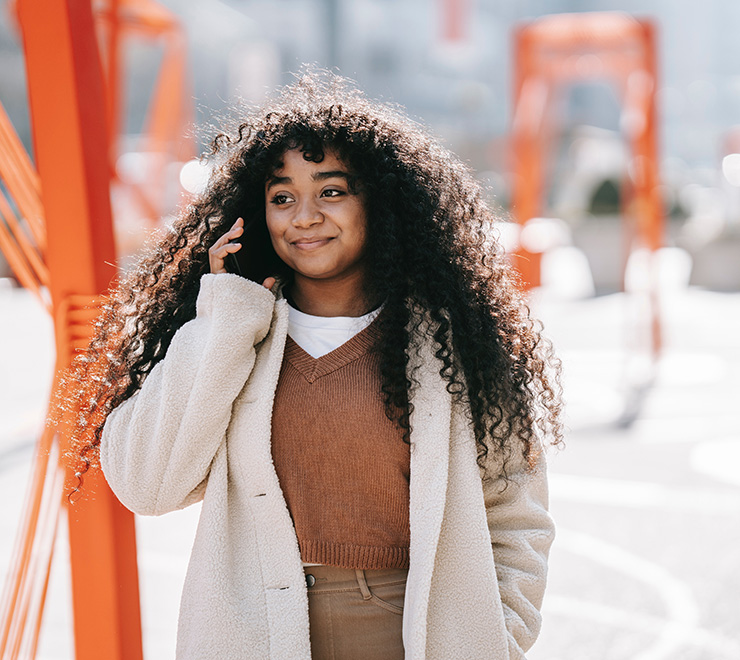What does identity mean to you? Everyone has a different reaction to this question, and that’s OK. You may find that you don’t know how to answer, may not have a complete answer, are still figuring it out or have a reply that changes over time. Here, you can reflect on your response by making your own zine about the various elements of your identity.
It takes time and reflection
— André-Louis, Kids Help Phone counselling manager
Discomfort and support
Trials and errors
Self-compassion and open arms
To finally live it out.
What do I need to know about identity?
Identity is something everyone has. It’s made up of all of the things that make you, you! Everyone figures out their identity at their own pace, and it can change over time. You can think of it like observing outer space — you notice the moon, stars, planets, etc., and eventually, you discover an entire universe.
Each person’s identity is unique, but there are some common themes. Your identity may include things like your:
- age
- appearance
- community
- country of origin
- culture
- disability status
- economic status
- gender identity / gender expression / pronouns
- interests / hobbies
- job / education
- language
- race
- religion or spirituality
- sexual orientation
- social status
- strengths
- wellness
- and more
Your identity may also include how these pieces fit (or don’t seem to fit) together, which is often one part of intersectionality (video from Learning for Justice, a U.S. resource). Different parts of your identity can change depending on the situation, the time in your life and what’s most important to you.
Sometimes, sharing your identity with others can feel tough, especially when it’s not the same as what you notice around you. Being who you are can even feel unsafe, especially because of how society is set up. What you spot your friends / family doing, and what you view on social media, in the news, on TV, etc., don’t always show all of the ways someone can be or live.
Reflecting on your identity is an ongoing and personal process. It’s about doing what feels right, what feels you and what affirms your identity. It’s also about finding people / spaces that respect, accept and celebrate your identity.
What is a zine?
A zine is like a mini magazine. They’re usually made (using materials that are easy to find / that you may already have) by people on topics they’re passionate about or interested in. Zines are often important in spreading messages about things that the mainstream media don’t cover. They can also be a way for young people to explore their identity on their own. Here’s an example of a zine to help you picture it: Navigating Rural Landscapes as 2SLGBTQ+ Youth (Grey-Bruce Collaborative Zine).
How can I explore my identity with a zine?
Kids Help Phone is here to support you, listen to you and help you find ways to #LiveItOut! To get started, you can download, print and fill out the zine template below to reflect on your identity as you view it now. On this page and in the PDF, you’ll see instructions on how to fold your zine, and questions to help you fill it in.
We want to let you know that this activity is for you to use on your own, or with someone you trust. You don’t have to share your zine with anyone else if you don’t want to (including Kids Help Phone). You can keep your zine in your pocket or in a place where you can refer to it often. You can also come back to this activity from time to time to see if your zine changes as you continue to explore.
You can write / draw in the spaces in the PDF to fill out your responses to the questions. When you’re ready, you can fold your paper along the dotted lines to finish your zine.
Click on the image to download a PDF of Kids Help Phone’s zine template!
Step 1: Print!
- Once you’ve downloaded the file, you can print it in either colour or black and white — it looks good either way!
- Make sure you’ve selected “double-sided,” and that it flips on the “long edge” — this way both sides of the sheet will line up with each other.
- The sizing should be set to “actual size” — this will help ensure that each of the zine pages are in the right place for folding, and that nothing gets deleted.
- Remember that you can ask a parent / caregiver, teacher, friend or someone else you trust to help you with any of these steps!
Step 2: Hot dogs and hamburgers!
- Now we’re going to do some folds, and one cut, so that the right pages can line up with each other. This is probably easiest to do with the comic side facing up.
- Our first fold is a “hot dog” fold, folding the paper evenly in half along its length. The result should be a long strip with comic panels on either side (like a hot dog!).
- Next, we’ll unfold it and then fold it again with a “hamburger” fold, folding it evenly in half along its width. The result should be a more evenly rectangular strip with the comic panels still on either side.
- While it’s in the hamburger fold, we’ll use scissors to cut along the line of our hot dog fold from the folded side, but NOT all the way through. It should be a straight cut between the comic panels numbered 4 and 7 on one side, and comic panels numbered 3 and 8 on the other.
Step 3: Zine magic!
- Now we’re going to unfold our paper, and it should have a straight cut along the middle lengthwise, but otherwise, still be in one piece. If you cut too far, don’t worry, just print another one and start over!
- We’ll do our hot dog fold again, taking care this time to make sure all of our folds are straight and even. This’ll make the zine line up better, but it’s OK if it’s a little uneven.
- If you can, hold the paper in both hands (your fingers should be on pages 5 and 6 on one end and the cover and page 2 on the other) and gently push it in towards the middle. The hamburger fold we did earlier should let it flatten into a shape that looks like a “plus” sign from above.
- Flatten the plus sign so that it’s a rectangle with page 8 and the cover on one side, and page 4 and 5 on the other. Pages 2, 3, 6 and 7 should be hidden inside for now while we make sure our edges line up properly.
- Do one more hamburger fold, so that the cover and page 8 are on the outside. Now your paper’s turned into a zine!
Step 4: Exploring your universe
- Now your zine should be organized like a book, letting you read through the pages in order. Remember that when you turn a page, it’ll be two pieces of paper at a time connected by a fold (that’s what holds the whole thing together!).
- If your page numbers don’t follow in order, don’t be afraid to unfold it and go back a few steps to try again. This size of zine can be tricky to figure out the first couple of times!
- Once you’ve read through the comic, you can unfold it back to a flat sheet of paper and follow the instructions again with the poster side facing up instead. This will give you a zine that you can fill out (by writing or drawing) with all of the things that make you, you!
1
The universe of my identity
2
I am more than what people see. How I look is just a part of my identity.
3
I am also my culture and my community.
4
I am the people I love and who love me.
5
I am the things I love to do and share with others.
6
I can be proud about what sets me apart, and loud about what is unfair.
7
All of these things and more make up who I am. And together, they become the universe of my identity.
8
The universe of my identity is my own to name and explore, to keep to myself, or to share with those I trust. If I want to talk about my identity, or get support with anything on my mind, I can check out KidsHelpPhone.ca for information and resources 24/7.
Kids Help Phone would like to thank Markus Harwood-Jones & Myriad Augustine for designing this piece and for their support of youth mental health and well-being.
1
The universe of my identity
2
What names and pronouns do I use?
3
What does community mean to me?
4
Who do I trust to celebrate me?
5
What does identity mean to me?
6
What people and places are important to me?
7
Where do the different parts of my identity connect / overlap?
8
What are the parts of my identity that make me, me?
Kids Help Phone would like to thank Markus Harwood-Jones and Myriad Augustine for designing this piece and for their support of youth mental health and well-being.

